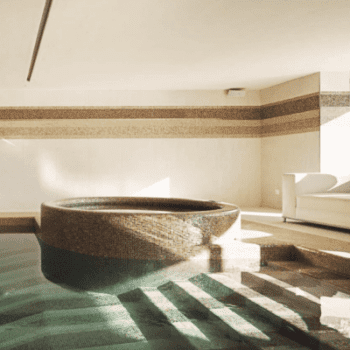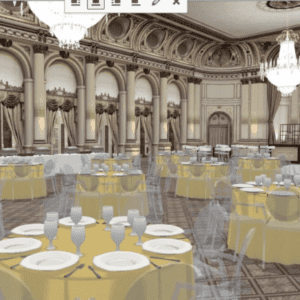 The wellness industry is rapidly growing into a trillion-dollar market, offering ample opportunities for new businesses to enter the sector with innovative products or services. EHL has compiled a list of the top global spa trends for 2024, indicating that the spa experience has evolved beyond pampering to include a wide range of healing therapies for the mind, body, and soul, as well as non-invasive treatments for those who wish to make minor adjustments to their physical appearance.
The wellness industry is rapidly growing into a trillion-dollar market, offering ample opportunities for new businesses to enter the sector with innovative products or services. EHL has compiled a list of the top global spa trends for 2024, indicating that the spa experience has evolved beyond pampering to include a wide range of healing therapies for the mind, body, and soul, as well as non-invasive treatments for those who wish to make minor adjustments to their physical appearance.
Spa trends 2024
Treatments for looking and feeling good
Looking and feeling good is high on the agenda for anyone with the spare income to afford it in 2024. The spa services market represents an 88-billion-dollar global industry and is expected to grow by over 17 percent to 260 billion dollars between 2023 and 2030.
The spa services market is somewhat riding on the coattails of the wider wellness industry which is currently experiencing rapid growth. Statista values the global wellness market at a staggering 4.27 trillion-dollars, this pertains to everything health and wellness including health drinks, supplements, exercise equipment and services, medical care and so on. Whereas the wellness & spa industry include day spas, nail salons, massage parlors, and saunas.
Today, spas may answer most of the desires of an older generation expecting to be offered additional pampering services or a health & well-being destination from the broad spectrum of wellness resorts, thermae and thalassos to the more specific medispa and health clinics. But what is the future potential of the spa? And what has caused this growth?
Fuelled by growing concerns about the true ‘mental health’ crisis which is threatening to bubble over in the aftermath of the pandemic, a newfound importance for ensuring our bodies and minds are fighting fit, and a desire to always look Instagram-ready hospitality businesses with a spa or health & wellness offering are set to reap the benefits.
The six key pillars driving the growing health and wellness market*:
- Better health
- Better fitness
- Better nutrition
- Better appearance
- Better sleep
- Better mindfulness
*According to McKinsey Research
Let’s take a look at some of the key themes that make up the top global spa trends for 2024.
The med spa
Tomorrow will see the wellness industry absorbing and enlarging the services, offers and features of the spa and the hotel itself, which has some of the most substantial key assets for a global wellness lifestyle proposal. It is not a surprise as many of these wellness destinations already exist in Asia, more mind and spirit-oriented, and in the US, more fitness and nature-oriented.
Technology in spas
Tomorrow is a time of artificial intelligence (AI). The younger generations are awake to the need of disease prevention rather than waiting to be sick and finding a cure. Positive psychology, pro-active and preventive medicine are now terms used in this growing segment where the hospitality industry and its wellness spas are ideally positioned to answer their customers’ aspirations.
The hospitality industry needs to adapt its customer journey to integrate programming the proper wellness services. First step, diagnostics: words like ‘assessment’, ‘evaluation’ and ‘prescription’ are used in preventive healthcare. Therapeutic sessions or wellness programs do not need to be done by doctors anymore but by educated physiotherapists and other experts.
These assessments can be made easier thanks to AI sub-products: fitness and body scanning machines and connected devices that allow the identification of many physical conditions. Connected health and the monitoring of the various tests results will enable the personalisation of preventive health programs. This type of personalisation will be further strengthened as a key asset of hospitality.
After identifying the wellness and fitness issues, the spa programming manager may offer à la carte or general programs available at the spa that will enlarge and diversify the offer, with wellness services carried out by experts, not doctors. Osteopaths, fitness coaches, deep tissues therapists will be able to deliver soothing experiences with an expert human touch. Naturopaths, psychologists, relaxologists, yoga masters will be able to conduct personal or group sessions to develop vitality, healing, stress management, emotional balance, mindfulness and better sleep.
The human touch
The younger generations, being so virtually and digitally connected, live in a less physical environment than their elders who are used to moving around in a more physically expressive world. Lately, Covid has aggravated this phenomenon and put a stop to more traditional greetings (e.g., a handshake, hug or kiss). Physical contact will be a deficit for the younger generation. Spa massages and other person-to-person treatments will offer a uniquely human touch and serve as a reminder that this basic tradition is fundamental to one’s wellbeing.
Be at one with nature
Regular contact with nature has recently become a proven way of combatting stress and promoting wellbeing. For the spas of the future, architects should integrate as many nature features as possible and air circulation in all its forms, from wide-open bays to the new sophisticated artificial purified environments. Natural experiences and discovery excursions should be made available in the vicinity. Time spent in natural outdoor spaces has physiological and psychological benefits, such as reduced stress responses and improved mood.
Away from the traditional packages offered by many spa and wellness centres that highlight only the wet and dry rooms, therapies and treatments, it’s a good idea to create more awareness of the advantages of mother nature via nature trails, wild nature therapy and outdoor massage for example.
Mental wellness
The digitally connected world has many benefits but has not yet created paradise on earth. Youngsters have fewer issues to contend with in the real world but nonetheless, they do have other pressures that can take their toll: social network harassment, a sense of isolation, stress at work or at school. We will be witnessing more mental pathologies than physical ones in the future. The taboo of mental health issues is slowly beginning to crumble with more and more people having the courage to speak up about depression, burn-out and problems that do not have a physical manifestation.
We mentioned earlier that the lifestyle of the millenniums should include pro-active or preventive medicine, which extends to the mental as well. The hospitality industry does not need to transform itself into a health destination, however, it should seek to offer an answer to the expectations of their new clients who will be looking at living a healthy life, preventing diseases and unnecessary stress, avoiding exhaustion and, when they go to restaurants, being nourished smartly. All professional attitudes will need to encompasss a sense of mindfulness and balance.
Stress management
Stress levels have risen for a variety of reasons since the pandemic: a sense of fear and isolation, disconnectedness from community and loved ones, economic insecutity. These circumstances have had a negative impact on many people’s mental wellbeing. What can a spa offer? Certainly a gentler option than standard medication in pill form.
Traditional Chinese medicine and Ayurvedic methods have become increasingly popular thanks to their holistic approach and the way they connect mind and body. Their appeal lies in the fact that they address the source of the problem, not just the symptoms. Similarly, alternative healing therapies such as acupuncture and reflexology are now as well known as massage and should be regular features in the spa offer.
Growing dietary needs
The veganism food movement that has swept across the western world in recent years, picking up momentum and growing in popularity due to increasing concerns for the environment among millienials and Gen Z. Not only veganism, there are a whole host of diets to cater for nowadays (pescatarian, vegetarian, paleo, dairy-free, Celiac, etc), and there is growing evidence that dietary intolerences and allergies are on the rise too.
Allergies aside, poor eating habits and their physical outcomes can be prevented, and the hospitality industry has the opportunity, if not the responsibility, to pay attention and communicate the benefits of its culinary positioning. Enjoyable food and menus built by chefs with nutritionists’ help may be the best way to satisfy these clients for whom diet is a permanent concern
It is a fact that people have also realised the importance of immune-boosting eating habits. Spa packages should concentrate on this regard and offer individualized menu selections for clients. This should not be limited only to medical spa and wellness operations. Proper nourishment is a key factor of well-being. Employing or collaborating with a nutritionist will add more value to the offering.
Sleep & relaxation
Sleep therapies are becoming more popular to combat insomnia and sleep problems as opposed to taking sleeping medication. To give a concrete example: The Amangiri Resort recently launched a “sleep retreat” in the Utah desert offers holistic spa therapies as well as mental and emotional support for better sleep. In Switzerland, the Grand Resort Bad Ragaz now offers yoga retreats to cultivate health, healing and happiness in our lives, because nothing is more precious than inner peace and tranquillity. An accent on certain types of meditation and introspective therapies can attract a new line of clientele looking for ways to retrain their mind and body.
Tweakments: non-invasive cosmetic procedures
The demand for non-surgical cosmetic treatments is surging, as individuals prioritize achieving plump, youthful-looking skin or the coveted “Instagram face” over concerns about potential negative outcomes or medical complications. Injections of botulinum toxin and dermal fillers have now become the most prevalent non-surgical cosmetic procedures on a global scale, with the market for these “tweakments” projected to witness a remarkable 15.4% growth by 2030.
What was once the beauty secrets of the rich and famous, social media and popular reality shows have made these types of non-invasive cosmetic procedures commonplace. The rise in popularity has brought about a swath of under-qualified practitioners looking to cash on the trend from unassuming clientele looking for a cheap fix. For both safety and the best cosmetic results, only receive cosmetic tweakment procedures such as injectables from a medically trained practitioner. Spas are well placed to offer such beauty treatments, as well as private clinics, and even dentists.



















